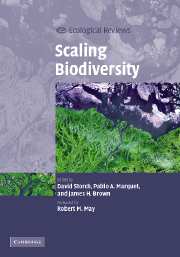Book contents
- Frontmatter
- Contents
- List of contributors
- Foreword by Robert M. May (Lord May of Oxford)
- Preface
- 1 Introduction: scaling biodiversity – what is the problem?
- PART I Spatial scaling of species richness and distribution
- PART II Alternative measures of biodiversity: taxonomy, phylogeny, and turnover
- 7 Biodiversity scaling relationships: are microorganisms fundamentally different?
- 8 The importance of phylogenetic structure in biodiversity studies
- 9 On the quantification of local variation in biodiversity scaling using wavelets
- 10 The scaling of spatial turnover: pruning the thicket
- PART III Scaling of biological diversity with energy and the latitudinal biodiversity gradient
- PART IV Processes, perspectives, and syntheses
- Index
- Plate section
- References
7 - Biodiversity scaling relationships: are microorganisms fundamentally different?
Published online by Cambridge University Press: 05 August 2012
- Frontmatter
- Contents
- List of contributors
- Foreword by Robert M. May (Lord May of Oxford)
- Preface
- 1 Introduction: scaling biodiversity – what is the problem?
- PART I Spatial scaling of species richness and distribution
- PART II Alternative measures of biodiversity: taxonomy, phylogeny, and turnover
- 7 Biodiversity scaling relationships: are microorganisms fundamentally different?
- 8 The importance of phylogenetic structure in biodiversity studies
- 9 On the quantification of local variation in biodiversity scaling using wavelets
- 10 The scaling of spatial turnover: pruning the thicket
- PART III Scaling of biological diversity with energy and the latitudinal biodiversity gradient
- PART IV Processes, perspectives, and syntheses
- Index
- Plate section
- References
Summary
Introduction
One of the key goals of ecology is to understand the spatial scaling of species diversity. Spatial patterns of species diversity provide important clues about the underlying mechanisms that regulate biodiversity and are central in the development of biodiversity theory (MacArthur & Wilson, 1967; Rosenzweig, 1995; Brown, 1995; Gaston & Blackburn, 2000; Hubbell, 2001; Holyoak, Leibold & Holt, 2005). Assumptions regarding the spatial scaling of biodiversity are a fundamental component of conservation biology and are frequently used to identify local- and global-scale priority conservation areas (Ferrier et al., 2004; Desmet & Cowling, 2004) and to predict extinction risk due to climate change (Thomas et al., 2004) and habitat loss (Gaston, Blackburn & Goldewijk, 2003). Although scaling patterns have been documented in hundreds of studies of plant and animal diversity, such patterns in microbial species (i.e. bacteria, archaea, and single-celled eukarya) have not been well documented. This is a serious omission, given that microorganisms may comprise much of Earth's biodiversity (Whitman, Coleman & Wiebe, 1998; Torsvik, Ovreas & Thingstad, 2002) and play critical roles in biogeochemical cycling and ecosystem functioning (Balser, 2000; Wardle, 2002; Morin & McGrady-Steed, 2004). Furthermore, microbial biodiversity is a major source of novel pharmaceuticals and other compounds of industrial importance, and an understanding of the scaling of microbial biodiversity is crucial to the search for such compounds (Bull, 2004).
- Type
- Chapter
- Information
- Scaling Biodiversity , pp. 129 - 149Publisher: Cambridge University PressPrint publication year: 2007
References
- 5
- Cited by

